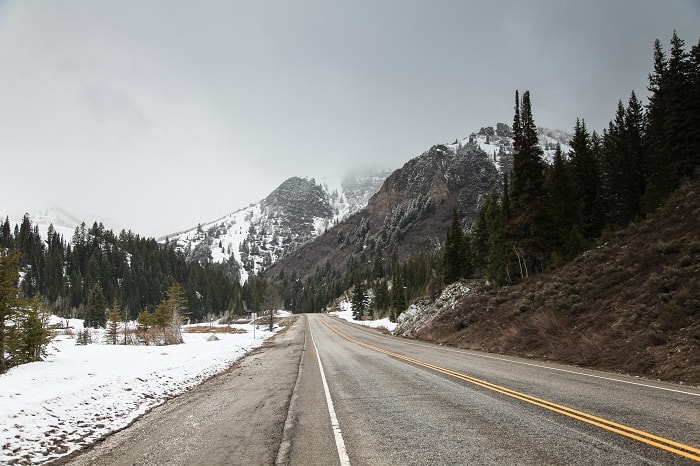
The following story was written and reported by The Utah Investigative Journalism Project in partnership with Utah Stories.
In the 2018 Legislature, then-Senate President Wayne Niederhauser, one of the most powerful legislators on the hill, presented a bill in a committee to pave the way for toll roads to be established in the state.
The soft-spoken Sandy Republican explained to the committee that it was time for changes in the way transportation projects are funded. While the gas tax once could fund road projects statewide, it had now fallen to the point of being “obsolete.” As proof, he pointed to an example in his district—the roads leading up Big and Little Cottonwood Canyon that were in need of lane expansions and other vital maintenance to deal with congestion.
“On a snowy day, or a weekend, or busy, if you go up the canyon and there’s an avalanche or work being done, the cars are backed up into neighborhoods for miles,” Niederhauser testified. “It’s an amazing situation.”
He discussed the Utah Department of Transportation’s study of how to address congestion in the canyon. “They’re going through that process, looking at the options, and tolling has to be one of them.”
What he didn’t tell the committee was that he and his business partner owned prime real estate at the mouth of Big Cottonwood Canyon, a development with a planned parking garage perfectly positioned to profit from vehicles looking for a convenient park and ride location to carpool up the canyon or take a shuttle and avoid paying the toll.
Neither Niederhauser nor a representative of Canyon Centre would comment for this article.
Niederhauser bid a fond farewell to public service at the end of the session in March 2018 to rousing applause from his colleagues on the hill. Ducking back into the full-time private sector, his development project, Canyon Centre, was then quickly able to negotiate a deal in April with the county and Cottonwood Heights for a public easement that would use public tax dollars to fund the construction of a $7.75 million parking garage at the development. The garage will offer hundreds of stalls that will benefit the condo owners, businesses and guests of a planned hotel at the development—and in exchange for public support, it will offer just 80 paid parking stalls exclusively for the public.
The parking garage will also include 202 stalls with certain public availability at different times of the day—though they will also be available to visitors of the development’s businesses and condo tenants.
Congestion Conundrums
In November 2019, UDOT released its Little Cottonwood Canyon Environmental Impact Statement, which sketched out a broad vision for managing growth and congestion on the canyon roads. That plan gave early indications of the need for tolling on the roads. According to UDOT spokesperson John Gleason, the document found public support for “developing congestion-based pricing and implementation of a toll in conjunction with expanded transit service to incentivize transit usage.”
In the spring of 2018, the Cottonwood Heights Redevelopment Agency began working out a plan to help Niederhauser’s development build its parking garage with public support.
The deal, finalized in December 2018, used tax-increment financing to pay for the multilevel parking garage. The garage was an instrumental feature of the seven-acre development. The whole development will include upscale luxury townhomes, an office park, a hotel and retail business spots. When complete, members of the public could park and take a shuttle or carpool up the canyon, come back down and enjoy a dinner, or go shopping at the development. Business travelers and vacationing snow junkies could stay at the hotel and be minutes from the resorts.
By using tax increment financing, Cottonwood Heights City Redevelopment Agency sets a baseline property tax rate for the development, for this deal the 2016 tax rate. A significant chunk of taxes that exceed that baseline level going into the future will be used to pay off the parking garage, and when the garage is finished those funds are converted into a purchase price for the public easement. That means for the next two decades and longer, a certain amount of property taxes that would have gone to Salt Lake County, the Canyons School District, the Salt Lake County Library and other local agencies, will be diverted to paying off the construction loan given to the developers for building the parking garage and purchasing the easement.
No Affordable Housing
Cottonwood Heights City spokesman Tim Beery says the city was aware of Niederhauser’s role in the Canyon Centre development but denied that Niederhauser’s help setting up the toll road law helped give him and his partners an advantage in the deal they struck with the city.
“The [Redevelopment] Agency is unaware of any negative or positive impact of Mr. Niederhauser’s involvement,” Beery says in an emailed statement.
“The Agency believes, however, that the project was judged solely on the anticipated public benefit of making available for public use—particularly on holidays and weekends—a large number of parking stalls near Big and Little Cottonwood canyons,” Beery says.
The city did not respond as to whether favoritism was shown to the developers by not requiring them to follow a legal requirement to provide at least 10% moderately affordable housing at the Canyon Centre despite a 2016 state law requirement for such housing projects.
The issue came up briefly in a December 18, 2018, Cottonwood Heights City Council work session.
“Where’s the 10% for housing coming from?” asked councilwoman Christine Mikell. Jason Burningham, a consultant for the Cottonwood Heights Community Development and Renewal Agency, explained that the development did not have to follow a 2016 requirement to provide 10% moderate affordable housing, because the development was originally planned in 2011, and at that time there was no affordable housing requirement. Taylor also told the council, however, that the original 2011 development plan didn’t have any housing—nevertheless the city considered the now dramatically different plans to be grandfathered in and would not need to provide affordable options.
“That’s a major change,” Burningham said.
None of the council registered any concerns about that, and they moved on to other business.
While the tax increment financing would take decades to pay off the garage, if tolling is put into place that might also provide a source of revenue for aiding in such projects. Back in 2018 when Niederhauser was arguing for the tolling bill he even floated the idea before his colleagues on the committee that future toll funds could be used “for busing and to pay potentially for parking garages” in the canyons area.
“In Little Cottonwood Canyon, you can’t park anymore,” Niederhauser said.
RELEVANT STORIES:
Utahns’ Love Affair with Cottonwood Canyon
Affordable Housing Crisis: Utah Urbanites find solution in Cohousing Projects such as Wasatch Commons Cohousing
The Cottonwood Canyons Foundation—Improving Millcreek, Big and Little Cottonwood Canyons for Today, Tomorrow
Saving Our Canyons From Ourselves
Babs DeLay: Utah’s Housing Market Suffers Under The Weight of California Migrants





